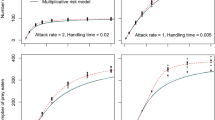Summary
We evaluated three methods for the analysis of functional response data by asking whether a given method could discriminate among functional responses and whether it could accurately identify regions of positive density-dependent predation. We evaluated comparative curve fitting with foraging models, linear least-squares analysis using the angular transformation, and logit analysis. Using data from nature and simulations, we found that the analyses of predation rates with the angular transformation and logit analysis were best at consistently determining the “true” functional response, i.e. the model used to generate simulated data. These methods also produced the most accurate estimates of the “true” regions of density dependence. Of these two methods, functional response data best fulfill the assumptions of logit analysis. Angularly transformed predation rates only approximate the assumptions of linear leastsquares analysis for predation rates between 0.1 and 0.9. Lack-of-fit statistics can reveal inadequate fit of a model to a data set where simple regression statistics might erroneously suggest a good match.
Similar content being viewed by others
References
Akre BG, Johnson DM (1979) Switching and sigmoid functional response curves by damselfly naiads with alternative prey available. J Anim Ecol 48: 703–710
Anderson S, Auquier S, Hank WW, Oakes D, Vandaele W, Weisberg HH (1980). Statistical methods for comparative studies. J Wiley and Sons, Inc, New York
Collins MD, Ward SA, Dixon AF (1981) Handling time and the functional response of Aphelinus thomsoni, a predator and parasite of the aphid Drepanosiphum platanoidis. J Anim Ecol 50:479–488
Cox DR (1970) The analysis of binary data. London, Methuen
Dixon WJ, Brown MB (1979) BMDP-79 Biomedical computer programs p-series. University of California Press, Berkeley
Draper N, Smith H (1981) Applied regression analysis, 2nd ed. J Wiley and Sons, Inc, New York
Hassell MP, Lawton JH, Beddington JR (1977) Sigmoid functional responses by invertebrate predators and parasitoids. J Anim Ecol 46:249–262
Juliano SA, Williams FM (1985) On the evolution of handling time. Ecolution 39:212–215
Juliano SA, Williams FM (1987) A comparison of methods for estimating the functional response parameters of the random predator equation. J Anim Ecol 56:641–653
Lenteren JD van, Bakker K (1976) Functional responses in invertebrates. Neth J Zool 26:567–572
Livdahl TP, Stiven AE (1983) Statistical difficulties in the analysis of predator functional response data. Can Ent 115:1365–1370
Mosimann JE, James FC (1979) New statistical methods for allometry with application to Florida red-winged blackbirds. Evolution 33:444–459
Murdoch WW, Oaten A (1975) Predation and population stability. Adv Ecol Res 9:1–131
Nicholson AJ, Bailey VA (1935) The balance of animal populations. Proc Zool Soc Lond 3:551–598
Nie NH (1983) SPSS X User's Guide. McGraw-Hill Book Co, New York
Rogers DJ (1972) Random search and insect population models. J Anim Ecol 41:369–383
Snedecor GW, Cochran WG (1980) Statistical methods, 7th ed. The Iowa State University Press, Ames, Iowa
Thompson WR (1924) La theorie mathématique de l'action des parasites entomophages et le factor du hasard. Annls Fac Sci Marseille 2:69–89
Williams FM, and Juliano SA (1985) Further difficulties in the analysis of functional response experiments and a resolution. Can Ent 117:631–640
Author information
Authors and Affiliations
Rights and permissions
About this article
Cite this article
Trexler, J.C., McCulloch, C.E. & Travis, J. How can the functional reponse best be determined?. Oecologia 76, 206–214 (1988). https://doi.org/10.1007/BF00379954
Received:
Issue Date:
DOI: https://doi.org/10.1007/BF00379954




